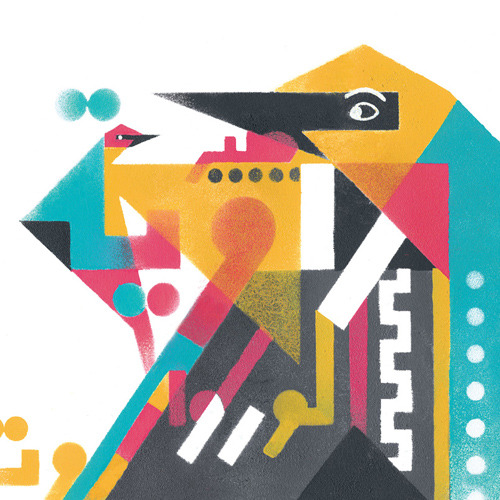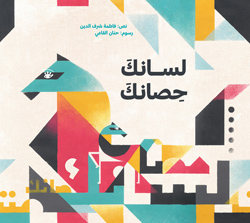< Back to posts
Hanane Kai
Lebanon

Hanane Kai is a Lebanese illustrator and graphic designer who studied at Notre Dame University—Louaize near Beirut. She was shortlisted for the Etisalat Arabic Children’s Book Award and the Mahmoud Kahil Award, before winning the 2016 Bologna Ragazzi Award in the ‘New Horizons’ category.
In this post, Hanane talks about her approach to illustrating the highly-inventive ‘Lisanak Hisanak’ (Tongue Twisters). This Bologna Ragazzi Award-winning picturebook was written by Fatima Sharafeddine and published in the United Arab Emirates by Kalimat.
Hanane: One calm Sunday, I got an email from Kalimat Publishing. The email read: ‘Would you like to illustrate this tongue twister book (text attached)?—Diana’
I had to research what ‘tongue twister’ meant. Then I read the text and I felt a beautiful contained excitement... It's a challenging project! I love design challenges. For me, this is where really good work can be done.
‘How much wood could a woodchuck chuck if a woodchuck could chuck wood?’ Imagine you had to create a visual for this tongue twister. Would you illustrate a woodchuck ‘chucking’ wood?
This is what the tongue twister talks about, but not what the tongue twister and all tongue twisters are actually about. Tongue twisters are about the amusing confusion that happens verbally when read out loud. And it was very clear to me that this was exactly the concept that I wanted to give a visual form to.
What actually makes tongue twisters confusing is the repetition of one or a couple of letters in one sentence. This repetition is as much verbal as it is visual, which is how I immediately got the vision of the book: I decided to use modular Arabic letters to create illustrations that would take readers to a world that is as confusing and fun as the verbal one.
I imagined the letters of each tongue twister tangled together. But I also didn't want the illustrations to be just an abstract composition. So I made each illustration hint at the meaning of each tongue twister without it being too literal or obvious. It's a puzzle, and needs to require some effort for readers to figure it out. For example, if a tongue twister is about carrots, you'd see a rabbit instead. The illustrations also hide the words of each tongue twister in them.
Now I had the vision, it was time to create the illustrations for each tongue twister. Some of them were instinctive. Like this one that says: ‘Rudi turns and gets dizzy’. The first part of this tongue twister transliterates to: ‘Rudi idur’.
If you reverse the word R-U-D-I you get I-D-U-R (which means turns). By flipping the word ‘Rudi’ upside down and positioning it above the word ‘idur’, I got a beautiful shape and I made readers have to turn the book upside down to be able to decipher the illustration, and get dizzy with all the turning.
Another example is this tongue twister: ‘The words of Kamal continue the words of Malak’.
By repeating the tongue twister without any space between the words, and by randomly colouring the letters, I created this simple visual that readers have to decipher. The riddle is to know where the sentence starts from and where it ends. This is a visual play on the meaning of the tongue twister: the words of Kamal and Malak continue each other.
Many tongue twisters were instinctive like Rudi's and Kamal's. Others needed more brain-picking. And by trying to create something puzzling, I got myself puzzled more times than I can count.
Diana, art director at Kalimat Publishing, told me one day: ‘Between Rudi turning, and Khaled moving to and fro, Diana is getting really dizzy!’
To further reinforce the repeating aspect of tongue twisters, when multiple books are displayed side by side, the front cover illustrations continue seamlessly across the books. Same for the back cover.
One of the most challenging of all tongue twisters was: ‘Aata and Aatwa in Tanta’. Aata and Aatwa being names of people, and Tanta being a city in Egypt. Try and create a meaningful visual for a sentence about two people in Tanta... Except that Tanta isn't any city; it's one of the most populated cities in Egypt. I had heard about Tanta before, but I needed to know more about this city. After some research, I discovered that most people visit Tanta to go the famous Mosque, Sayid Ahmed el Badawi, during the Moulid festival in October. This created context and content for the illustration.
Can you solve the riddle of this tongue twister? ‘Silk thread on my aunt's wall’.
The process of the book was mesmerising to me – from creating the concepts of the visuals, to the hand-colouring. The hand-colouring involved applying each colour on its own. Some of the illustrations would be so nice to look at when only one or two colours had been applied. I would get these beautiful unexpected shapes that no-one would have actually designed as a final outcome, and yet they formed surprisingly interesting compositions.
Last year (2015), I was selected to participate in the ‘Etisalat Award for Children's Books’ workshop. The workshop offered me a trip to attend the Bologna Book Fair. I was overwhelmed by the amount of talent in the illustrator's exhibition, and that was when I decided that my work was going to be hung on this wall some day. Fast-forward a few months: ‘Lisanak Hisanak’ wins the 2016 Bologna Ragazzi Award in the ‘New Horizons’ category.
Although this is my fourth book, I can't help but feel that this achievement marks the beginning of a life-long journey dedicated to creating books that open up readers' imaginations and make them think.
Illustrations © Hanane Kai.
Lisanak Hisanak /
Tongue Twisters
Fatima Sharafeddine & Hanane Kai
Kalimat Publishing, United Arab Emirates, 2016
‘The inventive modular composition of this vibrant book combines a repeated series of simple geometrical shapes in primary colours... Cleverly crafted juxtaposition of the images hides the words, which if pronounced wrongly, lead to an amusing jumble of the patterns.’
—The Bologna Ragazzi Award Jury














